“Sleep is the golden chain that ties health and our bodies together.” (Thomas Dekker, 1572-1632).
Historical definition:
“The intermediate state between wakefulness and death: wakefulness being regarded as the active state of all the animal and intellectual functions, and death as that of their total suspension.” (Robert MacNish, The Philosophy of Sleep, 1834).
Current definition:
“Sleep is a reversible behavioral state of perceptual disengagement from, and unresponsiveness to, the environment.” (Mary Carskadon & William Dement, 2011).
So, WHY do we sleep?
The answer is reasonably simple – it is a biological necessity. Humans are not mechanical machines or computers that can operate constantly. Sleep research indicates that there is no single reason as to why we sleep, but a combination of reasons. We need sleep to rest our bodies, restore and refresh energy, consolidate memory, problem solve and prepare for the next active part of the 24-hour cycle; work, study, sport or play. Sleep is essential for health and well-being, both physical and mental, and good quality, well-regulated sleep can greatly reduce the risk of disease.
In a nutshell, humans need to take a break from being awake. Sleep researchers have learned about the importance of sleep, by observing the dysregulation of human behaviour and daytime functioning when we are sleep deprived.
…and HOW do we sleep?
Sleep is an involuntary, yet dynamic behaviour, and is controlled by biological circuits and electrical activity within the brain, which in turn, is controlled by the presence of light and dark.

Sleep across the night changes between stages, in cycles of about 90 minutes duration. Non-REM (non-rapid eye movement) sleep is the deep, restful sleep needed for restoration of our physical bodies. Heart-rate, breathing and body temperature drops to slow the body down – and rest. In general, non-REM sleep is about 80% of healthy Total Sleep Time (TST). Non-REM sleep is characterised by high amplitude, low frequency brain wave activity, sometimes called slow-wave sleep.
Rapid Eye Movement (REM) sleep is our dreaming time, with the eyes moving rapidly behind closed eyelids, as if we were observing our surroundings in exactly the same way as we do when awake. The purpose of REM sleep is for memory consolidation, what we need to remember or not from that day’s wakefulness activities, and problem-solving. REM sleep constitutes about 20% of healthy TST. REM sleep is characterised by low amplitude, high frequency brain wave activity, similar to and not far below the threshold of wakefulness. Hence in the morning, we are more likely to wake from our dreams, rather than from deeper sleep.
…and finally, WHAT controls our sleep?
As with almost every function of our bodies, day and night, the sleep-wake cycle is controlled by ‘the body clock’ – yes we all have one! Specifically, the body or master clock is the Supra-Chiasmatic Nuclei or SCN. The SCN consists of about 20,000 neurons, located deep in the brain within the hypothalamus, and its circadian rhythm runs close to, but not exactly, 24 hours. This is known as the circadian process (circa = ‘about’; diem = ‘day’). The SCN has connections to photosensitive retinal ganglion cells in the eyes. The primary factor in controlling the operation of the SCN is its response to light and dark, and these variations in light affect the circadian rhythms of all physiological and psychological processes across the day. Therefore, exposure to light at a regular start time each day after good sleep at night, is the key to efficient, healthy and well-balanced physical and cognitive functioning, every day.

Sitting in conjunction with the daily circadian rhythm (Process C, left) is our homeostatic pressure to sleep at any given time, our sleep drive or sleep pressure (Process S, left). After awakening from a good night’s sleep at 7am, we are highly unlikely fall asleep again at say, 8am. But as our busy mind and body functions continue across the day, we gradually build up pressure to sleep, so that when we reach, say 11pm (or maybe earlier), we are indeed ready to fall asleep soon after going to bed. Sleep pressure then dissipates while we sleep, ready to reset again next morning. This explanation of sleep is the ‘Two-Process Model’ (Borbely, 1999). As you can see, these two processes need to be well-synchronised for good sleep health, including alertness, concentration and energy at the right times of the day.